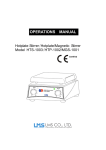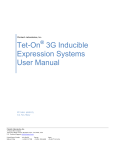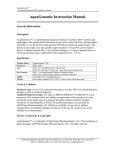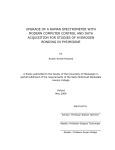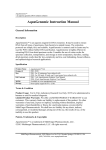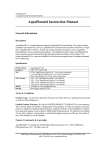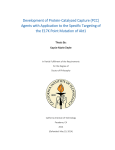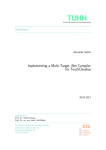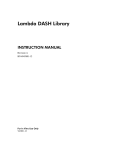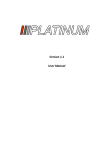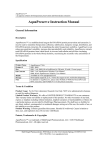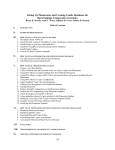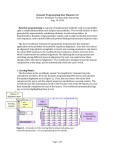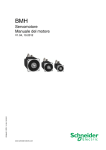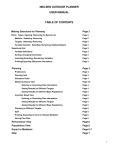Download AquaMutant User Manual - MultiTarget Pharmaceuticals
Transcript
AquaMutant - a reagent kit for introducing random mutagenesis AquaMutant Instruction Manual General Information Description Random mutagenesis is a powerful tool for life science research. Activated AquaMutant can chemically modify nucleobases, and cause base substitutions during DNA replication in vitro and in vivo. By treating biological samples with activated AquaMutant, researchers can create various mutant libraries. The mutant libraries may be used to investigate biological processes and disease mechanisms, screen for enzymes and antibodies with improved properties, and use directed evolution to generate mutants with desired functionalities and phenotypes. Specification Product Name Product # Size Kit Contents MSDS Storage AquaMutant Kit 1201, 1215 1201: Varied, 1215: Varied, depending on sample volume 1201: 1 ml each AquaMutant, Start and Stop Solutions, User Manual 1215: 15 ml each AquaMutant, Start and Stop Solutions, User Manual Available at www.aquaplasmid.com Store tightly capped at room temperature (~22 °C) Terms & Condition Product Usage: For In Vitro Laboratory Research Use Only. NOT to be administered to humans or used for medical diagnosis. Limited Product Warranty: We offer a LIMITED PRODUCT WARRANTY to our customers. This warranty limits our liability to replacement of this product. No other warranties of any kind, express or implied, including without limitation, implied warranties of merchantability or fitness for a particular purpose, are provided by MultiTarget Pharmaceuticals. We shall have no liability for any direct, indirect, consequential, or incidental damages arising out of the use, the results of use, or the inability to use this product. Product Warning: Highly mutagenic upon activation by mixing the AquaMutant solution with the Start solution. The activated solution may be carcinogenic. Avoid direct contact. Patents, Trademarks & Copyrights AquaMutant is a trademark of MultiTarget Pharmaceuticals, LLC. 2014 Multitarget Pharmaceuticals, LLC. All rights reserved. MultiTarget Pharmaceuticals, 825 N 300 W, Suite W-108, Salt Lake City, Utah 84103 (801) 769-6586, www.aquaplasmid.com AquaMutant - a reagent kit for introducing random mutagenesis A. In vitro random mutagenesis WARNING: ACTIVATED AQUAMUTANT IS A STRONG MUTAGEN. Wear protective lab coat, gloves, masks and goggles to prevent skin contact or ingestion of the reagent! WARNING: Selection or evolution of dangerous mutants or pathogens may be dual-use research of concern (DURC). You must seek pertinent permits and carry out DURC studies in appropriate biosafety facilities. 1. AquaMutant activation: Activated AquaMutant is unstable and should be prepared immediately before use. To activate AquaMutant, mix the AquaMutant solution and the Start solution at a ratio of 1:1 (e.g., 100 µl each) and incubate at 22 °C for 5 min. 2. AquaMutant treatment: Suspend the DNA (restriction fragment or PCR product, 0.550 µg) in 1 ml of deionized water. Divide it into 8 x 100 µl aliquots in eight 1.5-ml microfuge tubes labeled #1-8. Add 100 µl of activated AquaMutant to Tube #8, mix well and then remove 100 µl to Tube #7, and so on to obtain activated AquaMutant concentrations of 0, 0.78, 1.56, 3.12, 6.25, 12.5, 25, and 50% (v/v). Incubate the samples at 37 °C for 4-24 hours. (Note: To ensure a large library size and full representation, micrograms of DNA may be used in each reaction. To further simplify in vitro random mutagenesis, you may directly treat the plasmid DNA containing the gene of interest with activated AquaMutant and disregard mutations elsewhere in the plasmid for the time being). The mutation rate is dependent on AquaMutant concentration and treatment time, users may prepare a concentration series (e.g., 0.1-100% activated AquaMutant at 37 °C for 4 hours) and a time series (e.g., 1, 2, 4, 8, 24 hours at 10% activated AquaMutant) to control the mutation rate for their specific projects. The DNA samples treated with different AquaMutant concentrations and exposure time may be pooled to obtain a library containing mutants with various degrees of mutations or they may be processed separately to obtain a smaller and manageable mutant library for screening.) 3. Reaction termination: Add 0.5 vol of Stop solution (with respect to the activated AquaMutant solution, e.g., for 50 µl activated AquaMutant used, add 25 µl of Stop solution) to the sample. To clean up the mutated DNA, mix the stopped reaction with an equal vol of 3 M sodium acetate (pH unadjusted, do not use acidic sodium acetate or the DNA will not precipitate), and then with an equal vol of isopropanol (e.g., for 50 µl of DNA, 50 µl of activated AquaMutant, 25 µl of Stop solution, and 125 µl of 3M NaOAc, add 250 µl of isopropanol). Incubate at 22 °C (do not incubate in the freezer) for 30 min and centrifuge at 14,000 xg at 22 °C for 10 min to pellet the DNA. Aspirate to remove the supernatant. Add 1 ml of 75% ethanol to the DNA pellet and flip the tube to discard the ethanol solution. Repeat the ethanol rinse once. Air-dry the DNA pellet by leaving the opened microfuge tube up-side-down on a paper towel for about 15 min. Suspend the DNA pellet in TE buffer for PCR amplification or direct cloning. MultiTarget Pharmaceuticals, 825 N 300 W, Suite W-108, Salt Lake City, Utah 84103 (801) 769-6586, www.aquaplasmid.com AquaMutant - a reagent kit for introducing random mutagenesis B. In vivo random mutagenesis WARNING: ACTIVATED AQUAMUTANT IS A STRONG MUTAGEN. Wear protective lab coat, gloves, masks and goggles to prevent skin contact or ingestion of the reagent! WARNING: Selection or evolution of dangerous mutants or pathogens may be dual-use research of concern (DURC). You must seek pertinent permits and carry out DURC studies in appropriate biosafety facilities. AquaMutant may be used to introduce random mutations in live cells or model organisms. It is simple to carry out and does not require prior genetic knowledge to study a phenotype. Multiple related genes may be mutated concurrently. It is particularly suitable for direct evolution to create mutants with desired properties. 1. AquaMutant activation: Activated AquaMutant is unstable and should be prepared immediately before use. To activate AquaMutant, mix the AquaMutant solution and the Start solution at a ratio of 1:1 (e.g., 100 µl each) and incubate at 22 °C for 5 min. 2. AquaMutant treatment: Concentrate the virus (e.g., phages) or bacteria or cells or organism to be mutated in 50 µl of saline or culture medium. Aliquot 100 µl of saline (Important: Do not use culture media for the reaction as they may contain excess amount of nucleotides and other components, which may quench the activated AquaMutant) in eight 1.5-ml microfuge tubes labeled #1-8. Add 100 µl of activated AquaMutant to Tube #8, mix well and then remove 100 µl to Tube #7, and so on to obtain activated AquaMutant concentrations of 0, 0.78, 1.56, 3.12, 6.25, 12.5, 25, and 50% (v/v). Add 1µl of the concentrated microbes to be mutated into each tube. Incubate the samples at 37 °C for 4 hours. (Note: Millions of individual cells or organisms may be needed in each reaction in order to obtain the desired mutations and phenotypes. The volumes given are for illustration only and should be adjusted appropriately for different samples, e.g., small volumes for virus but large volumes for worms. The mutation rate is dependent on AquaMutant concentration and treatment time, users may prepare a concentration series (e.g., 1 -100% activated AquaMutant at 37 °C for 4 hours) and a time series (e.g., 1, 2, 4, 8, 24 hours at 10% activated AquaMutant) to control the desired mutation rate for their specific cells or organisms). 3. Reaction termination: Add 0.5 vol of Stop solution (with respect to the activated AquaMutant solution, e.g., for 50 µl activated AquaMutant used, add 25 µl of Stop solution) to the sample. Immediately pellet the treated cells by centrifugation to remove the treatment medium and resuspend the cells in fresh culture medium. Alternatively, the treated cells may be diluted directly in the culture medium without removal of the treatment medium as long as the final AquaMutant concentration is diluted to less than 1% (some species may be more sensitive or have stronger repair mechanism than the others). Determine the viability of the culture after 24-72 hours. Freeze down aliquots of the amplified mutant library before applying selection pressure to the remaining culture. MultiTarget Pharmaceuticals, 825 N 300 W, Suite W-108, Salt Lake City, Utah 84103 (801) 769-6586, www.aquaplasmid.com AquaMutant - a reagent kit for introducing random mutagenesis Frequently Asked Questions Please read through these questions carefully. The answers provide additional helpful tips and useful information for the successful use of AquaMutant. 1. How should I store the AquaMutant kit? AquaMutant, its Start and Stop solutions may be stored at room temperature for 12 months. 2. How does AquaMutant work? AquaMutant is a proprietary formulation of mutagenic chemicals, which may be activated upon mixing with the Start solution. The activated AquaMutant can modify the bases of DNA to cause base substitutions during DNA synthesis in vitro and in vivo. 3. What types of mutation does AquaMutant introduce? AquaMutant primarily modifies A, C, and G, causing base transitions (50-60%) and transversions (30-40%). The mutation rate may be controlled by varying the concentration of activated AquaMutant and its exposure time. Direct sequencing of plasmid DNA treated with 100% activated AquaMutant at 37 °C for 24 hours shows substitutions at nearly every nucleotide positions. 4. What precautions should I take using AquaMutant? WARNING: ACTIVATED AQUAMUTANT IS A STRONG MUTAGEN. You must wear protective lab coat, gloves, masks and goggles to prevent skin contact or ingestion of the reagent! Activated AquaMutant can be readily destroyed by autoclave. It can also be quenched and inactivated by mixing with bacterial culture media, such as LB medium. Unactivated AquaMutant solution should be disposed as hazardous waste in accordance with local regulations. 5. What type of study may be classified as DURC research? While selections or evolutions of dangerous mutants or pathogens, such as making them drugresistant, vaccine-resistant, more virulent, transmissible, or having a broader host range, etc., are necessary for understanding their mechanisms and developing countermeasures, they could be misused, therefore, are dual-use research of concern (DURC). You must seek pertinent permits and carry out DURC studies in appropriate biosafety facilities. You should handle microorganism mutant libraries as biohazards and not release them into the environment. 6. My random mutagenesis didn’t work, what may be the causes? If your random mutagenesis failed, it is likely that the host (e.g., TOP10 E. coli strain) may be able to repair the AquaMutant modified nucleobases or the mismatches. You may either first amplify the mutated plasmid by PCR or transform it into a MutS E. coli strain, such as BMH 7118 to amplify the library before its selection in the host strains of interest. MultiTarget Pharmaceuticals, 825 N 300 W, Suite W-108, Salt Lake City, Utah 84103 (801) 769-6586, www.aquaplasmid.com




